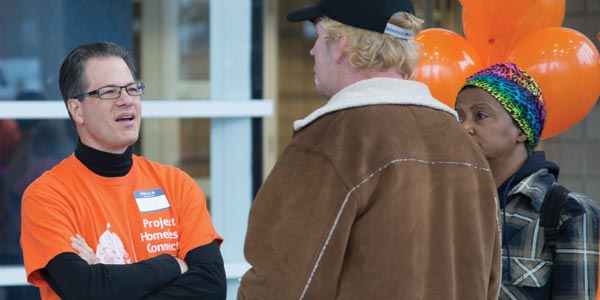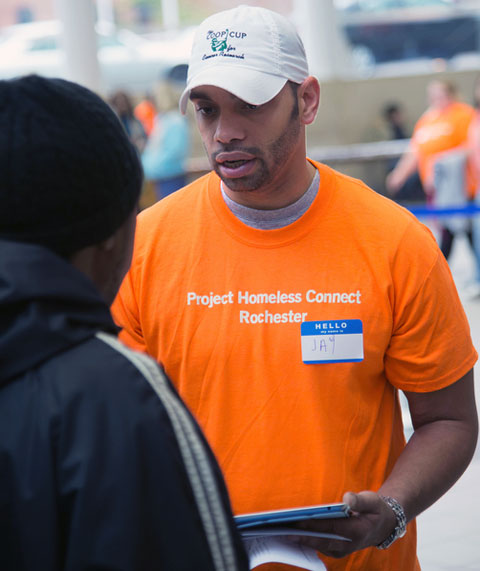Beyond Self
Helping the Homeless
During Project Homeless Connect Rochester, Nazareth social work students and faculty match struggling people with the help they need to get back on their feet
by Sofia Tokar
The stereotypical face of homelessness is usually male, bearded, older, and perhaps holding a cardboard sign or rattling a cup of change.
“There are some people like that who are homeless,” says Jed Metzger, Ph.D., associate professor in social work at Nazareth College. “But many more are families, veterans, youth, senior citizens, or individuals who identify as LGBTQ.”
Challenging that stereotype is one of the results of Project Homeless Connect (PHC), an annual daylong, “one-stop-shop” collaborative event that serves people who are homeless or at risk of becoming homeless. PHC provides essentials, such as meals, clothing, and haircuts. It also connects people with a range of services, from medical and dental care to legal counseling and housing aid.
Based on the national model created in San Francisco, the Rochester-based event is held each fall in the Blue Cross Arena at the War Memorial. Nazareth’s Social Work Department has been a partner and sponsor for the last three PHC events, ever since the organizers contacted Metzger for advice. For Metzger, the partnership created an opportunity to help the community while also educating his students.
When colleges and communities collaborate
This year’s Project Homeless Connect Rochester hosted approximately 800 homeless or near-homeless people. Nazareth-affiliated volunteers included 45 undergraduate social work students, 100 graduate students from the College’s joint master’s program with SUNY Brockport, and six social work faculty members.
“We paired each guest with a social work student,” says Metzger. With so many services in one place, it was important to tailor the experience to the needs of each visitor. A student volunteer could host a guest for anywhere from 20 minutes to two hours.
“Social workers combine book-learning with practical skills,” explains Metzger. “They have to learn how to effectively engage with people they don’t know—and also how to be useful to them.”
Denise Hynson ’12, ’14G first volunteered for this project in 2013. “One of my guests was a gentleman who slept in the parking garage across the street,” she recalls. “He was a Gulf War veteran but was adamant about not accepting handouts.”
As Hynson guided him to and from the different booths, they talked about his experiences during Desert Storm. She finally convinced him that he had earned his right to access veterans benefits. He agreed to visit the booth and took the contact information for the local Veterans Affairs office.
“People forget that just because someone is homeless, that doesn’t mean they didn’t contribute to society. Everyone deserves respect regardless of socio-economic status,” Hynson says.
Connecting struggling people with appropriate aid
Undergraduate social work students from Nazareth also volunteered, allowing them to make a positive impact in their community while also applying what they have learned in classes.
“The first time I volunteered as part of a project for my research methods class,” says Elizabeth David ’15. “We conducted entrance and exit surveys with each guest to record their age, income, and other demographic information. We then analyzed the data and created a report about the people this project was helping.” Associate Professor of Social Work Leanne Wood Charlesworth’s undergraduate research methods students are responsible each year for the event’s data collection and improvement efforts.
This year David recruited fellow social work students as volunteers and worked one-on-one with guests. Taking the time to connect with individuals helped her to realize there is “no such thing as a typical homeless person.”
She believes that understanding how people are affected by social policies is crucial to changing those policies to better serve individuals and communities. For example, says David, “Someone might be having trouble with the Medicaid system. But only by talking to them can we determine why they’re having trouble. Is it a question of literacy, accessibility, or maybe something else?”
Making a difference in the Rochester community
According to Monroe County's Department of Human Services, it made 8,857 emergency housing placements for individuals and families in 2013.
The primary cause of homelessness in the Greater Rochester area is eviction. Other reasons include refugee displacement, domestic violence, fires, or being released from treatment or jail with no plans for permanent housing.
“Some people are only one or two paychecks away from experiencing homelessness,” says Hynson. “It’s important to remember that we’re all human. You never know when the day may come that you’re on the receiving end of assistance.”
Fortunately, Monroe County has lots of assets to offer those who need help. And because of Project Homeless Connect, a person experiencing homelessness or financial insecurity can obtain as many services in one day as would otherwise take months.
“We—at Nazareth, as social workers, as people living in Monroe County—have a responsibility to address the challenges in our community,” says Metzger. “We might not be able to solve the problem of poverty entirely, but we can go out in the world and help make it better.”
Sofia Tokar is a freelance writer in Rochester, New York.

Associate Profesor of Social Work Jed Metzger offers assistance at Project Homeless Connect.
Learn More
Social work: Learn more about Nazareth's social work programs.
Research: A Nazareth grant paid for T-shirts and transportation that enabled so many social work students to participate in the event. Learn more about the Office of Research, Scholarship, and Innovation, which assists faculty and staff in securing internal and external funding for scholarly research and activities.

Jay Rivera ’15, ‘17G, a veteran himself, helped conduct research and guide attendees at the event. Read more.